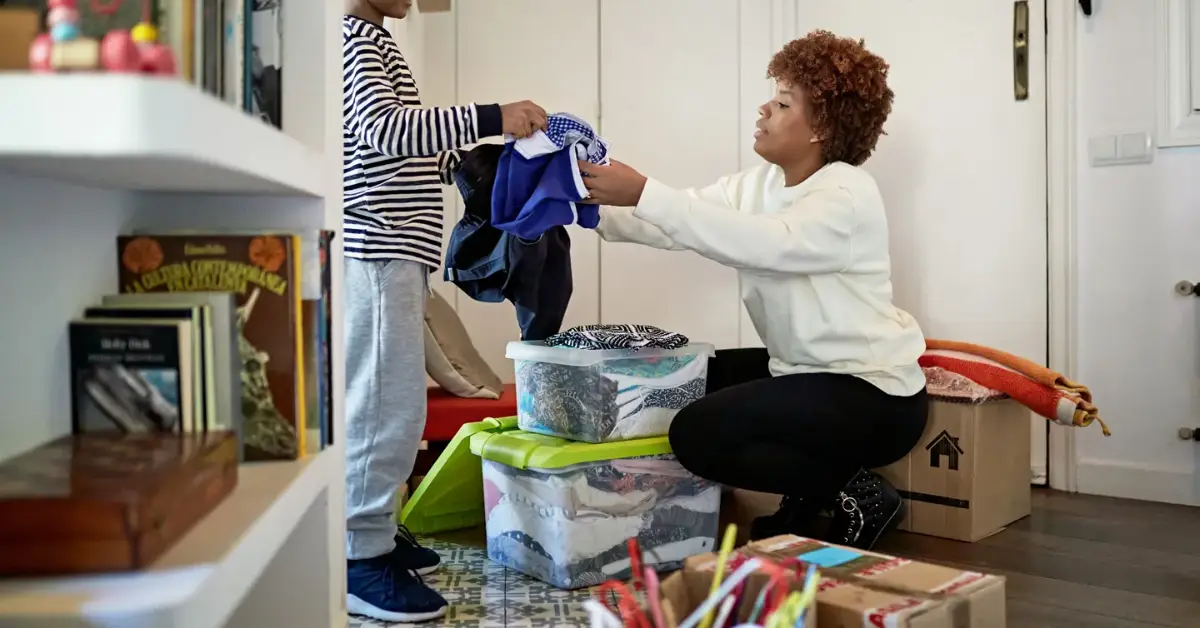Why the ‘5/7’ Decluttering Trick Is My New Favorite Home Hack
I used to dread tidying up. Piles of clothes, stacks of papers, and random kitchen gadgets made my apartment feel like a constant battle zone. Then I stumbled across something called the 5/7 decluttering rule, and honestly, it changed the game. It’s simple, surprisingly practical, and—dare I say—almost fun.
Instead of staring at clutter and feeling overwhelmed, this rule gives you a clear, no-guesswork method: if you haven’t used an item 5 out of the last 7 days, it might be time to let it go. That tiny shift in thinking suddenly made decision-making faster and tidying less of a chore.
Over the next few minutes, I want to show you exactly how this rule works, why it actually sticks, and how you can apply it in your own home—even if you’ve tried decluttering hacks before and failed. By the end, you’ll see that getting organized doesn’t have to feel like punishment—it can feel… almost fun.
Why the “5/7” Rule Works: Psychology + Habit Science
When I first tried the 5/7 rule, I thought it was just another tidying hack. But the more I applied it, the more I realized there’s real psychology behind it.
The “Use Frequency” Trigger: Why Tracking 5 of 7 Days Matters
Think about it: if you use something five times in a week, it’s clearly serving a purpose in your daily life. That frequency isn’t random—it’s your habits signaling what’s truly valuable. By paying attention to use rather than sentiment, you automatically separate what’s essential from what’s just taking up space.
Here’s what this does for you:
- You stop overthinking every item. The rule is clear: 5 of 7 = keep; less = consider letting go.
- Your space gradually fills only with things that genuinely support your lifestyle.
- You start noticing patterns—what you really reach for and what’s just “filler clutter.”
Habit science backs this up. Repeating actions strengthens neural pathways, making behaviors automatic. Items you use frequently reinforce their value in your mind, while unused items lose their emotional hold. For more insights on building lasting habits, see Harvard Business Review on habit formation.
Reducing Decision Fatigue and Clutter Inertia

One of the biggest reasons we procrastinate tidying is decision fatigue—so many choices, so little clarity. The 5/7 rule simplifies that. By narrowing decisions to a single, measurable criterion, you:
- Reduce overwhelm instantly.
- Avoid the “maybe I’ll need it someday” trap.
- Keep your energy for meaningful tasks rather than endless debating over items.
Over time, I noticed that tidying became almost effortless. The smaller the rule, the less mental friction, and the more likely you are to maintain it consistently.
How to Apply the “5/7” Rule in Your Space
Now that you understand why it works, let’s get practical. Here’s how I implemented it room by room—and how you can too.
Step‑by‑Step Implementation for One Room
Start small. Pick a single area and commit just 15–20 minutes. Ask yourself for each item: “Have I used this 5 of the last 7 days?” If not, it goes into one of three piles:
- Donate / Sell – Items in good condition but no longer used.
- Relocate – Items that belong somewhere else in the house.
- Store / Archive – Things you might need seasonally but don’t require daily access.
If you want to explore another simple, actionable approach to decluttering, check out this guide on the 1‑3‑5 rule for decluttering your home.
Adapting by Category
Different types of items require slightly different interpretations:
- Clothes: worn 5 of 7 days, or definitely will wear in the next week.
- Kitchen gadgets: used 5 times in the last 7 days (or really often in a typical week). If your kitchen is feeling overwhelming, these seven steps make decluttering it simpler and more manageable.
- Paperwork & digital files: accessed frequently or actively needed.
Daily / Weekly Variations
If tracking exact days feels impossible, try variations:
- 5 items in 7 minutes: Quick wins when short on time.
- 5 items out of 7 weeks: For items you use seasonally, like winter gear or hobby tools.
- Customize your rhythm: Adapt to your lifestyle without overcomplicating the rule.
By breaking it into practical, realistic steps, you make decluttering a habit rather than a chore. And trust me, once you start seeing empty surfaces and organized spaces, the motivation just feeds itself.
Common Pitfalls and How to Avoid Them

Even a simple rule like 5/7 can trip you up if you don’t handle the tricky parts. I’ve learned that being prepared for common pitfalls makes the process smoother and less frustrating.
“What Counts as ‘Use’?” – Clarify Definitions and Grey Areas
One of the first questions I faced was: Does “use” mean touch it, wear it, or just think about it? The rule works best when you define “use” clearly for yourself:
- Physical interaction: You actually wear it, cook with it, or use it in the way it’s intended.
- Mental interaction counts selectively: For items you plan to use soon (like ongoing projects), counting thoughtful engagement can be okay.
- Consistency matters: Apply your definition consistently across items so the rule stays simple.
Being clear here prevents endless second-guessing and keeps the decluttering process fast and stress-free.
Emotional / Sentimental Items That Break the Rule
Not everything fits neatly into 5/7. Sentimental items—old gifts, childhood memorabilia, or heirlooms—often won’t meet the “5 of 7 days” test. Here’s what I do:
- Create a memory box: Keep items that matter emotionally in a designated space.
- Limit the space: Once the box is full, consider whether each new item deserves a spot.
- Rotate if necessary: Occasionally review items to see if they still spark joy or relevance. For items that are emotionally tricky or hard to let go of, this article shares seven practical secrets to make the process easier.
This approach lets you honor memories without letting sentiment dictate clutter.
If You Live With Others or Share Space – Making the Rule Work for Multi-Person Homes
Living with family or roommates introduces new challenges. I quickly realized that decluttering isn’t just about my habits—it’s about negotiation and shared agreements:
- Set common zones: Agree on which areas are shared and which are personal.
- Align expectations: Explain the 5/7 rule and its benefits; invite others to participate or adapt a shared version.
- Respect boundaries: Don’t declutter someone else’s personal items without consent, but offer support for shared items.
Getting buy-in from housemates makes the process collaborative, reduces conflict, and keeps clutter from creeping back. For practical strategies on negotiating shared spaces and habit adoption in households, Psychology Today on household behavior and habit formation provides useful insights.
Maintaining the Momentum – Making “Tidying Almost Fun”
Decluttering isn’t just a one-time effort—it’s about turning small actions into habits you can sustain. When I started using the 5/7 rule, I quickly realized that keeping momentum was the difference between temporary order and a home that actually stays tidy.
Turning the Rule into a Habit: Linking to Daily Triggers

One trick that worked for me was pairing the rule with something I already did every day:
- After my morning coffee, I tackle five items in one area.
- While waiting for dinner to cook, I clear five things from a countertop or desk.
- Use these micro-moments to reinforce the habit without feeling like extra work.
By linking decluttering to existing routines, it becomes automatic. You don’t have to think about it—your brain starts expecting these small wins daily.
Gamification and Rhythms – Challenge Yourself
Making decluttering a little fun goes a long way:
- Tick-box system: Mark each session on a calendar.
- App reminders: Use habit apps to nudge you daily.
- Family scoreboard: Turn it into a friendly challenge with roommates or family members.
Tracking progress and celebrating small victories turns the task from a chore into a game you actually enjoy.
When You Plateau: Next-Level Methods Beyond 5/7
Eventually, the basic 5/7 rule might feel too easy or routine. Here’s how I keep it fresh:
- 5/7 + 30-day revisit: Reassess areas you’ve already decluttered after a month.
- Category deep dives: Focus on tricky zones like paperwork, digital files, or seasonal items.
- Rotation system: Cycle items in and out to maintain order without letting clutter creep back.
Myths About Decluttering Rules
Even simple rules like 5/7 spark questions. Here’s what I’ve learned and how I tackle common concerns:
“What if I can’t remember my last 7 days of use?”
Approximate. Focus on consistent application moving forward rather than obsessing over the past week.
“Does this rule work for digital clutter or only physical items?”

Absolutely! Apply the same principle to files, apps, and emails: if you haven’t used it recently, consider archiving or deleting.
“Is the 5/7 rule minimalism or just tidying?”
It’s practical, not extreme. The rule is about keeping what you truly use and love—not forcing you into a minimalist lifestyle.
“Will I feel guilty discarding items under this rule?”
A little guilt is natural, but remember: decluttering is about clarity, not perfection. Items you let go of can bring value to someone else. You’re making space for what actually matters.
For further guidance and real-world examples of applying the 5/7 rule successfully, see Apartment Therapy on the 5/7 decluttering rule.
Taking Action: Your Next Steps with the 5/7 Rule
We’ve covered a lot—the psychology behind why the 5/7 rule works, practical ways to apply it in different rooms, handling tricky items, and how to make decluttering stick as a habit. But reading about it is only the first step. The real change comes from doing.
Here’s a simple action plan to get started tonight:
- Pick one zone in your home—a desk, a countertop, or a single drawer.
- Apply the 5/7 rule for just 10 minutes. Sort items into keep, donate, relocate, or archive piles.
- Repeat daily for a week. Track your progress with a tick-box or journal—it’s amazing how quickly momentum builds.
- Celebrate small wins. Even clearing one drawer feels like progress and keeps motivation high.
Remember, decluttering isn’t about perfection—it’s about creating a space that works for you. By taking small, consistent steps, you’ll notice your home feels calmer, more organized, and yes—almost fun.
I’d love to hear from you: Which area of your home are you starting with tonight? Leave a comment below and share your experience.
And if you want more tips, strategies, and step-by-step decluttering challenges, visit Build Like New—your hub for practical, actionable ways to refresh your home and your routines.
Disclaimer: The 5/7 decluttering rule is a guideline to help simplify your space. Results may vary depending on your lifestyle, home, and personal preferences. Always use your judgment when discarding items, and seek professional help if you feel overwhelmed by clutter.


